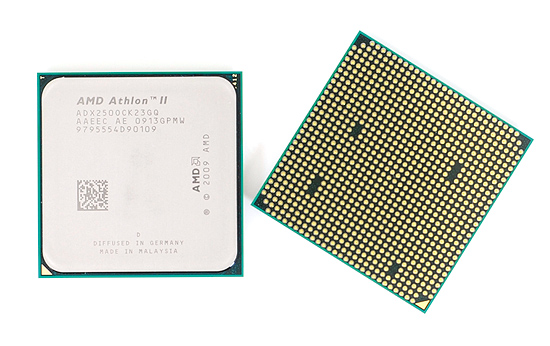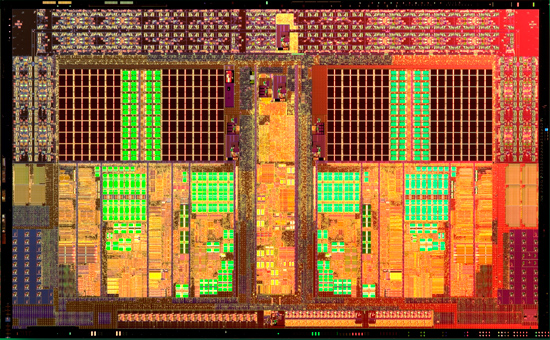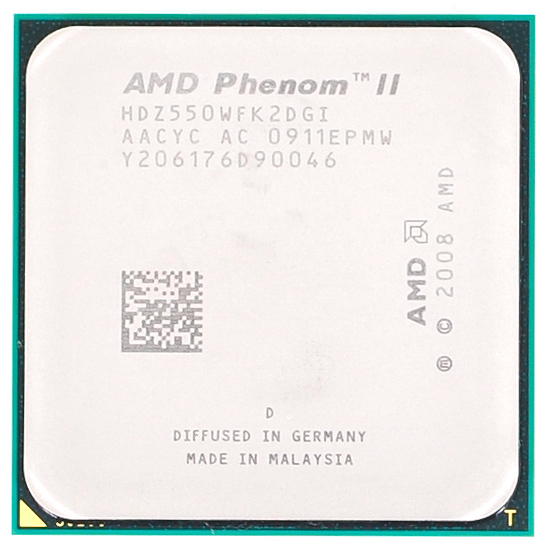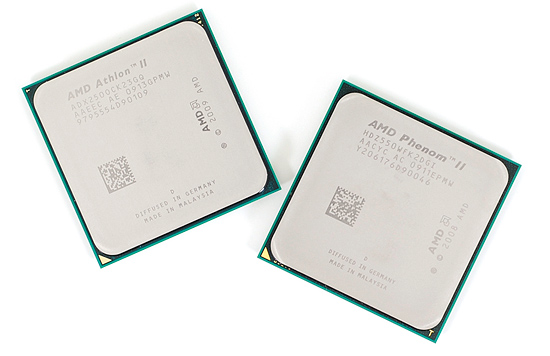The Athlon II X2 & Phenom II X2: 45nm Dual-Core from AMD
by Anand Lal Shimpi on June 2, 2009 12:00 AM EST- Posted in
- CPUs
“AMD in many cases delivers greater performance than the similarly priced Intel CPUs, but not nearly a large enough performance gap to make up for the difference in die size. Again, great for consumers, but potentially painful for AMD in the long run. As yields improve AMD should be able to make more of these cores members of the 900 family, but without a separate, smaller die there will still be economic inefficiencies at the lower end.”
“AMD’s Phenom II is very competitive, but the strategy does not have much long term staying power. AMD needs to introduce smaller die versions of its CPUs soon.”
Ask and you shall receive, right?
Intel did a bang up job tarnishing the Pentium name with its clock speed rampage during the Pentium 4 days, but the Athlon brand still holds a special place in our hearts.
This is the Athlon II, and it’s exactly what I’ve been asking for:

The Athlon II X2, to be specific, is a 45nm monolithic dual-core processor. While the most recent Athlon X2s are derivatives of the original Phenom architecture, the Athlon II is based on the new and improved Phenom II architecture.

The name lives on
Take two Phenom II cores, increase their L2 caches to 1MB, leave out the L3 and you’ve got an Athlon II. The entire die measures only 117.5 mm^2 and is made up of a meager 234 million transistors. The table below compares the Athlon II’s die size to other competing parts:
| Processor | Cores | Manufacturing Process | L1 Cache | L2 Cache | L3 Cache | Die Size | Transistor Count |
| AMD Phenom II X2 | 2 | 45nm | 128KB per core | 1MB | 6MB | 258 mm2 | 758M |
| AMD Athlon II X2 | 2 | 45nm | 128KB per core | 1MB per core | 0MB | 117 mm2 | 234M |
| AMD Athlon X2 | 2 | 65nm | 128KB per core | 512KB per core | 2MB | 285 mm2 | 450M |
| AMD Athlon 64 X2 | 2 | 65nm | 128KB per core | 512KB per core | 0MB | 126 mm2 | 154M |
| Intel Pentium for Desktop | 2 | 45nm | 64KB per core | 2MB | 0MB | 82 mm2 | 228M |
The new Athlon II is actually AMD’s smallest dual core processor ever, even smaller than the original Athlon 64 X2. It’s also AMD’s first 45nm dual-core processor. It’s also AMD’s first Socket-AM3 processor to carry the Athlon brand (ok, I’ll stop). As an AM3 chip it will work in both AM3 and AM2+ motherboards, just like the Phenom II.
The Athlon II is only launching with one model today the 3.0GHz Athlon II X2 250. Priced at $87, it’s likely that we won’t see more Athlon II X2s until AMD is ready to further switch its lineup over to 45nm in order to keep up with demand.
The Phenom II X2 550 BE
We actually get two new dual-core chips today, the second is the new Phenom II X2 550 Black Edition. Like all of the other chips in the Phenom II lineup, the X2 550 is simply a die-harvested Phenom II X4 part. In other words, what we have is a quad-core Phenom II with two of its cores disabled. Given that it’s still fairly early in GlobalFoundries’ 45nm manufacturing process, it makes sense to see so many harvested parts. I would expect these Phenom II X2 and perhaps even the X3 derivatives to either disappear or shift out of the limelight as AMD’s yields improve.

Because it’s based on the quad-core Phenom II processor, the X2 550 BE has a full 6MB L3 cache that the two cores can share. The L2 caches are still stuck at 512KB but with a large 6MB L3, there’s very little to complain about. The unlocked Black Edition part runs at 3.1GHz and retails for $102.
Availability and New Energy Efficient Phenom IIs
AMD is expecting availability for both of these parts in the next week or so.

The table below shows AMD’s new lineup with these two chips. Note that I’ve also included data on the Phenom II X4 905e and the Phenom II X3 705e. These two CPUs run at 2.5GHz and have a 65W TDP, down from 125W and 95W for all previous AM3 parts.
| Processor | Cores | Clock Speed | un-core Clock | L2 Cache | L3 Cache | TDP | Price |
| AMD Phenom II X4 955 BE | 4 | 3.2GHz | 2.0GHz | 2MB | 6MB | 125W | $245 |
| AMD Phenom II X4 945 | 4 | 3.0GHz | 2.0GHz | 2MB | 6MB | 125W | $225 |
| AMD Phenom II X4 940 BE | 4 | 3.0GHz | 1.8GHz | 2MB | 6MB | 125W | $225 |
| AMD Phenom II X4 920 | 4 | 2.8GHz | 1.8GHz | 2MB | 6MB | 125W | $195 |
| AMD Phenom II X4 910 | 4 | 2.6GHz | 2.0GHz | 2MB | 6MB | 95W | $??? |
| AMD Phenom II X4 905e | 4 | 2.5GHz | 2.0GHz | 2MB | 6MB | 65W | $195 |
| AMD Phenom II X4 810 | 4 | 2.6GHz | 2.0GHz | 2MB | 4MB | 95W | $175 |
| AMD Phenom 9950 | 4 | 2.6GHz | 2.0GHz | 2MB | 2MB | 140W | $173 |
| AMD Phenom II X4 805 | 4 | 2.5GHz | 2.0GHz | 2MB | 4MB | 95W | $??? |
| AMD Phenom II X3 720 BE | 3 | 2.8GHz | 2.0GHz | 1.5MB | 6MB | 95W | $145 |
| AMD Phenom II X3 710 | 3 | 2.6GHz | 2.0GHz | 1.5MB | 6MB | 95W | $125 |
| AMD Phenom II X3 705e | 3 | 2.5GHz | 2.0GHz | 1.5MB | 6MB | 65W | $125 |
| AMD Phenom II X2 550 BE | 2 | 3.1GHz | 2.0GHz | 1MB | 6MB | 80W | $102 |
| AMD Athlon II X2 250 | 2 | 3.0GHz | 2.0GHz | 2MB | 0MB | 65W | $87 |
| AMD Athlon X2 7850 | 2 | 2.8GHz | 1.8GHz | 1MB | 2MB | 95W | $69 |
And just for kicks here's a specs table with both AMD and Intel CPUs in it:
| Processor | Cores | Manufacturing Process | L1 Cache | L2 Cache | L3 Cache | Die Size | Transistor Count |
| AMD Phenom II X4 | 4 | 45nm | 128KB per core | 2MB | 6MB | 258 mm2 | 758M |
| AMD Phenom II X3 | 3 | 45nm | 128KB per core | 2MB | 6MB | 258 mm2 | 758M |
| AMD Phenom II X2 | 2 | 45nm | 128KB per core | 2MB | 6MB | 258 mm2 | 758M |
| AMD Athlon II X2 | 2 | 45nm | 128KB per core | 1MB per core | 0MB | 117 mm2 | 234M |
| AMD Athlon X2 | 2 | 65nm | 128KB per core | 512KB per core | 2MB | 285 mm2 | 450M |
| AMD Athlon 64 X2 | 2 | 65nm | 128KB per core | 512KB per core | 0MB | 126 mm2 | 154M |
| Intel Core i7 | 4 | 45nm | 64KB per core | 256KB per core | 8MB | 263 mm2 | 731M |
| Intel Core 2 Quad | 4 | 45nm | 64KB per core | 12MB | 0MB | 214 mm2 | 820M |
| Intel Core 2 Quad | 4 | 45nm | 64KB per core | 4MB | 0MB | 164 mm2 | 456M |
| Intel Core 2 Duo | 2 | 45nm | 64KB per core | 6MB | 0MB | 107 mm2 | 410M |
| Intel Core 2 Duo | 2 | 45nm | 64KB per core | 3MB | 0MB | 82 mm2 | 228M |
| Intel Pentium | 2 | 45nm | 64KB per core | 2MB | 0MB | 82 mm2 | 228M |










55 Comments
View All Comments
7Enigma - Thursday, June 4, 2009 - link
Hello Anand,In the article you seem to imply a tremendous difference in that 2meg to 3meg jump but your single data point doesn't show that conclusion.
In your example there is a ~9% increase in performance when going from 2 to 3 megs, but there is also a 4.5% increase in clockspeed between the 2 chips. So at best (in this example) you have a 5% difference, which while significant, I would't say it was tremendous.
Can you comment on whether you did any further tests with identical frequencies?
FlameDeer - Thursday, June 4, 2009 - link
Here are some corrections of AnandTech Bench.Refer to here:
http://www.anandtech.com/bench/default.aspx?b=25&a...">Adobe Photoshop CS4 results of few CPUs from AnandTech Bench
1. AMD Athlon II X2 250 results missing a dot, becoming slower than Intel Atom 230.
2. Better using "Intel Pentium Dual Core E5300" for E5300 as the name Intel printed on the CPU.
3. AMD Athlon LE-1620 notes (platform side notes) should be same as AMD Athlon LE-1640.
Thanks for adding more CPUs for comparison in AnandTech Bench, doing the full test in latest software is really time consuming especially for old CPUs. Take care.
MadAd - Wednesday, June 3, 2009 - link
would have liked to see phenom (non II) compared, especially the low end x3s, users may be thinking of upgrading from those about nowFlameDeer - Thursday, June 4, 2009 - link
You can always conveniently & interactively comparing them here.http://www.anandtech.com/bench/">AnandTech Bench
Elementalism - Wednesday, June 3, 2009 - link
I never had much luck running Cool n Quiet when I used to run AMD processors. Even in games the CPU was put into a low clock mode running at half speed. Sounds like a buggy implementation to this day.And I cant say in my experience it was the Mother Boards fault either. I enabled Cool and Quiet in the bios and nothing happened. It wasnt until I installed the Cool n Quiet driver all hell broke loose.
mino - Wednesday, June 3, 2009 - link
However one has to keep in mind the bug comes from Redmond.The Win 5.x scheduler is a piece of garbage and it allways was. It is just that it shows with different symptoms:
1 CPU core => crappy multi-tasking on heavy loads
2+ CPU cores => unable to get a grasp that power management not a thing of the future ...
A no, being from 2000 is no excuse, proper OS scheduler were there 30yrs ago.
Had MS decided to do so, their Win 5.x schedules would be a proper one from the start.
As for AMD, it is a price one pays for being ahead of the market.
Remember, it took Intel 5yrs (2003-2008) to get comparable power management capabilities as AMD with Nehalem.
mino - Wednesday, June 3, 2009 - link
sorry for the spelling mess..Hrel - Wednesday, June 3, 2009 - link
YAY 3D max, also that E7500 is beating the crap out of everything but AMD's top of the line. That really solitifies in my mind that picking the E8400 6 months ago for my friends gaming computer was the right choice. Stupid AMD, I REALLY want them to be competitive again so Intel is FORCED to stop overcharging for EVERYTHING.mmpalmeira - Wednesday, June 3, 2009 - link
Did you try to overclock the uncore of the AMD's CPUs?calyth - Tuesday, June 2, 2009 - link
Just like that article that you linked to with the name CnQ bug, I don't believe that a hardware manufacturer creates a bug if the OS scheduler can't seem to do the sensible thing and not bounce threads around. Although various factors in the AMD chips make the problem worse, bouncing threads across different cores on an Intel chip also has a bit of impact, since L1 and the L2 shouldn't be shared across cores on the i7 platform.So please, stop calling it a bug. The bug lies in Windows, not the chips.